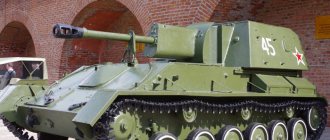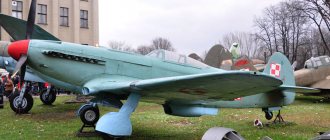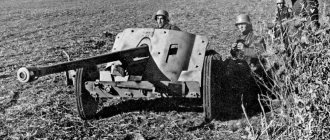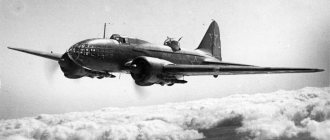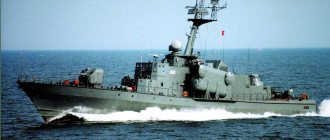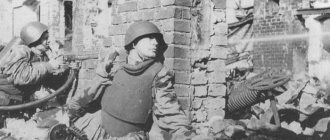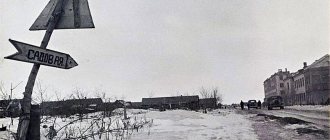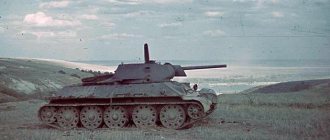Bombers
The bomber, from a tactical point of view, is an indispensable part of combat aircraft in any battle. Perhaps the most recognizable Soviet bomber of the Great Patriotic War is the Pe-2. It was developed as a tactical super-heavy fighter, but over time it was transformed into a dangerous dive bomber.
It should be noted that Soviet bomber-class aircraft made their debut precisely during the Great Patriotic War. The appearance of bombers was determined by many factors, but the main one was the development of the air defense system. Special tactics for using bombers were immediately developed, which involved approaching the target at high altitude, sharply descending to the bomb-dropping altitude, and an equally abrupt departure into the sky. This tactic yielded results.
Pe-2 and Tu-2
A dive bomber drops its bombs without following a horizontal line. He literally falls on his target and drops the bomb only when there are only 200 meters left to the target. The consequence of this tactical move is impeccable accuracy. But, as you know, an aircraft at low altitude can be hit by anti-aircraft guns, and this could not but affect the design system of bombers.
Thus, it turned out that the bomber had to combine the incompatible. It should be as compact and maneuverable as possible, and at the same time carry heavy ammunition. In addition, the design of the bomber was assumed to be durable, capable of withstanding the impact of an anti-aircraft gun. Therefore, the Pe-2 aircraft suited this role very well.
The Pe-2 bomber complemented the Tu-2, which was very similar in parameters. It was a twin-engine dive bomber, which was used according to the tactics described above. The problem with this aircraft was the insignificant orders of the model at aircraft factories. But by the end of the war the problem was corrected, the Tu-2 was even modernized and successfully used in battle.
Tu-2 performed a wide variety of combat missions. It served as an attack aircraft, bomber, reconnaissance aircraft, torpedo bomber and interceptor.
Fighter aircraft
Aviation researchers of World War II rightly consider this period to be the golden age of fighters. At that time there were no radars, computer equipment, thermal imagers or homing missiles. Only experience, the personal skill of the pilot and, of course, luck played a role.
In the 30s, the USSR occupied a high-quality level in the production of fighter aircraft. One of the first fighters to leave the Union factories was the I-16. It was in service in 1941, but, alas, could not resist the power of the Luftwaffe. Soviet aircraft of the Great Patriotic War only after a long modernization gave a worthy rebuff to the enemy in the sky. Fundamentally different, technologically powerful fighters began to be created.
Pe-8
During the war years, the Pe-8 bomber was so rare and unrecognizable that it was sometimes even attacked by its own air defenses. However, it was he who performed the most difficult combat missions.
Although the long-range bomber was produced back in the late 1930s, it was the only aircraft of its class in the USSR. The Pe-8 had the highest speed (400 km/h), and the fuel supply in the tank made it possible to carry bombs not only to Berlin, but also to return back. The aircraft was equipped with the largest caliber bombs, up to the five-ton FAB-5000. It was the Pe-8 that bombed Helsinki, Koenigsberg, and Berlin at a time when the front line was in the Moscow area. Because of its operating range, the Pe-8 was called a strategic bomber, and in those years this class of aircraft was just being developed. All Soviet aircraft of World War II belonged to the class of fighters, bombers, reconnaissance aircraft or transport aircraft, but not to strategic aviation, only the Pe-8 was a kind of exception to the rule.
One of the most important operations performed by the Pe-8 was the transportation of USSR Foreign Minister V. Molotov to the USA and Great Britain. The flight took place in the spring of 1942 along a route that passed through Nazi-occupied territories. Molotov traveled on the passenger version of the Pe-8. Only a few such aircraft were developed.
Today, thanks to technological progress, tens of thousands of passengers are transported every day. But in those distant war days, every flight was a feat, both for pilots and passengers. There was always a high probability of being shot down, and the downing of a Soviet plane meant the loss of not only valuable lives, but also great damage to the state, which was very difficult to compensate.
Concluding this short review, which describes the most popular Soviet aircraft of the Great Patriotic War, it is worth mentioning the fact that all development, construction and air battles took place in conditions of cold, hunger and lack of personnel. However, each new machine was an important step in the development of world aviation. The names of Ilyushin, Yakovlev, Lavochkin, Tupolev will forever remain in military history. And not only the heads of design bureaus, but also ordinary engineers and ordinary workers made a huge contribution to the development of Soviet aviation.
MiG-3 and Yak-9
The basis for the design of the MiG-3 fighter was the body of the MiG-1, it was destined to become a thunderstorm for Soviet military aviation, a worthy adversary to the German kites. The plane could reach speeds of up to 600 km/h (not all Soviet planes of the Great Patriotic War could afford such a speed). The MiG-3 could freely rise to a height of 12 kilometers, which was unrealistic for previous models. It was this fact that determined the combat purpose of the aircraft. It established itself as a high-altitude fighter and operated in the air defense system. After the war, many Soviet aircraft were developed on the basis of the MiG.
But against the backdrop of the positive aspects, the MiG-3 also had disadvantages. Thus, at an altitude of more than 5 kilometers, the plane lost speed and yielded to the enemy. Therefore, the developers began to replace it in this niche with the Yak-9 fighter. Light combat vehicles such as the Yakovlev-9 were agile and had very powerful weapons. The pilots literally admired this plane; flying it was the ultimate dream. The French allies from the Normandy-Niemen regiment also liked the fighter; after testing several models, they chose the Yak-9.
Both the MiG-3 and Yak-9 were armed with 12.7 or 7.62 millimeter machine guns. Some models had a 20mm cannon. But despite the fact that these weapons were considered powerful, Soviet WWII aircraft needed improved weapons.
La-5
The new product from Lavochkin Design Bureau no longer had this drawback; the La-5 was equipped with two ShVAK cannons. An air-cooled engine was also installed on the fighter. The motor was a little outdated, but it paid off, especially compared to liquid-cooled motors. The fact is that the liquid-cooled motor, although compact, was very gentle. It was enough for the smallest fragment to get into the engine and break at least some tube, it would immediately stop working. It was this design feature that forced the developers to install a large but reliable air-cooled engine on the La-5.
Frankly speaking, during the development of Lavochkin, very powerful and modern M-82 engines already existed; subsequently they became widespread, many Soviet aircraft would be equipped with them. But at that time, the engine had not yet been properly tested, and it could not be installed on the new La-5.
Despite all the difficulties, the La-5 was a fundamental step forward in terms of the development of fighter aircraft. The model was noted not only by Soviet specialists, but also by Luftwaffe pilots. The Lavochkin terrified German pilots, just like all other Soviet aircraft during the Great Patriotic War.
Biplane U-2
Perhaps the most recognizable and the first Soviet aircraft that made a special contribution to the victory - the U-2 biplane - was rather primitive and technologically unequipped. The reason for its lack of modernity was the initial development of the aircraft as a pilot training tool. The biplane could not carry any combat load due to its dimensions, design, take-off weight, and weak technical parameters of the engine. But the U-2 coped with the role of a “study desk” more than excellently.
And, by the way, quite unexpectedly, the biplane found quite real combat use. The aircraft was equipped with silencers and a holder for small bombs, and thus the biplane became an agile, stealthy and very dangerous bomber, firmly cementing this new role until the end of World War II. After the first successful experiments in using the U-2, a small-caliber machine gun was installed on the aircraft. Before this, pilots had to use only personal small arms.
IL-4
The Il-4 tactical bomber rightly earned the title of the most beautiful aircraft of the Great Patriotic War, making it difficult to confuse it with any other aircraft. The Ilyushin-4, despite its complicated controls, was popular in the Air Force; the aircraft was even used as a torpedo bomber.
The IL-4 is entrenched in history as the aircraft that carried out the first bombing of the capital of the Third Reich - Berlin. And this happened not in May 1945, but in the fall of 1941. But the bombing did not last long. In winter, the front shifted far to the East, and Berlin became out of reach of Soviet dive bombers.
Sturmovik Il-2
Perhaps the most legendary Soviet attack aircraft is the Il-2. Soviet WWII aircraft were manufactured according to a typical design, the frame was made of metal or even wood. The outside of the plane was covered with plywood or fabric. An engine and corresponding weapons were installed inside the structure. All Soviet aircraft during the war were designed according to this monotonous principle.
Il-2 became the first example of a new aircraft design scheme. Ilyushin’s design bureau realized that this approach noticeably worsened the design and made it heavier. The new design approach provided new opportunities for more rational use of the aircraft's weight. This is how the Ilyushin-2 appeared, an aircraft that earned the nickname “flying tank” for its particularly strong armor.
IL-2 created an incredible number of problems for the Germans. The aircraft was initially used as a fighter, but did not prove particularly effective in this role. Poor maneuverability and speed did not give the Il-2 the opportunity to fight fast and destructive German fighters. Moreover, the weak protection of the rear of the aircraft allowed the Il-2 to be attacked by German fighters from behind.
The developers also experienced problems with the aircraft. During the entire period of the Great Patriotic War, the armament of the Il-2 was constantly changing, and a seat for a co-pilot was also equipped. This threatened that the plane could become completely uncontrollable.
But all these efforts yielded the desired result. The original 20mm cannons were replaced with large-caliber 37mm ones. With such powerful weapons, the attack aircraft became feared by almost all types of ground troops, from infantry to tanks and armored vehicles.
According to some recollections of pilots who fought on the Il-2, firing from the guns of the attack aircraft led to the fact that the plane literally hung in the air from strong recoil. In the event of an attack by enemy fighters, the tail gunner covered the unprotected part of the Il-2. Thus, the attack aircraft actually became a flying fortress. This thesis is confirmed by the fact that the attack aircraft took several bombs on board.
All these qualities were a great success, and the Ilyushin-2 became simply an indispensable aircraft in any battle. It became not only a legendary attack aircraft of the Great Patriotic War, but also broke production records: in total, about 40 thousand copies were produced during the war. Thus, Soviet-era aircraft could compete with the Luftwaffe in all respects.
